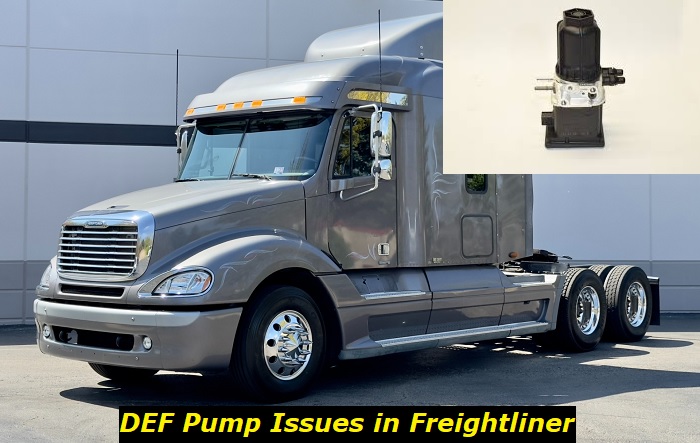Freightliner DEF Pump Problems: Reasons and Fixes
A Diesel Exhaust Fluid (DEF) pump is an electronically controlled device designed to transfer DEF through the diesel engine system to facilitate compliance with the strict Nitrogen Oxide emissions for heavy trucks like the Freightliner. The DEF is a mixture of urea (32.5%) and normal de-ionized water (67.5%).

In this article, we shall explain:
- The various problems that affect the DEF pump;
- What causes these problems;
- How to deal with and fix these problems.
What is the DEF System?
The DEF system comprises the pump and other devices that are fitted in large displacement diesel engines to meet the EPA's Tier IV emissions requirements. Specifically, the DEF is designed to deal with Nitrogen Oxide (NOx) gases which are emitted alongside other exhaust gases.
NOx is a highly reactive and poisonous gas produced when fuel is combusted at very high temperatures. Heavy machinery such as trucks, construction equipment, industrial plants, and sea vessels produce NOx gas in their normal running. NOx is an oxidizing agent that readily reacts with many atmospheric compounds to produce smog and other ozone-depleting agents.
EPA regulations require these engines to reduce NOx emissions by modifying combustion processes or installing control equipment like Selective Catalytic Reduction (SCR). The DEF system was introduced to facilitate this compliance. The DEF is placed in a separate tank and is pumped through the exhaust system to clean it up.
How it works
- The DEF is pumped and injected into the exhaust system before the SCR
- It turns into ammonia vapor as it enters the SCR
- In the SCR, it reacts with NOx to form Nitrogen and water.
- Nitrogen gas and water are harmless and are emitted into the atmosphere
The DEF Pump
The DEF pump is a critical component of the entire system. It is responsible for the proper circulation of the DEF in the system to check the NOx emission. It is designed to operate even in the harshest environment. The pump pushes the fluid from the tank into the exhaust stream through the DEF head.
However, like any other device, the DEF pump is prone to develop problems that prevent it from working normally. To begin with, DEF pumps are not your average type of pump. They are electronically controlled and make use of several sensors and valves to ensure they are working in unison with the Freightliner exhaust system. Thus, they are prone to technical and mechanical issues which may inhibit their proper operation.
The DEF systems have had a huge impact on environmental protection, but have also brought untold suffering and headaches to drivers. Some of the major problems relating to the DEF pump are caused by issues other than those relating to the pump itself. The most common problems are:
- Poor quality diesel exhaust fluid
- Failed sensors
- DEF pump-related issues
- Component failures
1. Poor Quality DEF
Poor quality DEF is one of the biggest causes of DEF pump failure. Low-quality DEF may cause severe damage to various DEF system components and may even cause a total DEF system collapse. The DEF quality can be compromised by:
- Crystallization
Crystallization of the DEF may occur through various mechanisms. If too much fluid is added to the system, the fluid is unable to hydrolyze and this leads to crystallization. Again, if you top up the DEF with hard water, it will lead to crystallization.
Crystallization builds up over time and the crystals are deposited in the pump's injector and exhaust nozzles causing a blockage and eventual pump failure.
Fixes:
Though it is usually difficult to test the current DEF in the tank for possible future crystallization, one can perform any one of the following:
- Visually check your pump nozzles and injectors for the presence of crystals.
- Lab testing for calcium (and other salts) deposits in the fluid using XRC or ICP Spectrometry.
- Confirming DEF quality from the manufacturer by asking for certification or submitting samples for testing.
However, to avoid the incidence of crystallization, ensure you top up your DEF up to the maximum indicated in the tank and also avoid using low-quality fluids, hard water, or unauthorized fluids.
- Dirt or Metal Contamination
When dirt or other metallic contaminants find their way into your DEF, they cause a lot of friction and abrasion, especially in the pump. The abrasion wears essential parts and components causing the pump to fail.
Dirt and metal parts may arise from poor storage, reusing old fluid, mishandling, or rust in the tank and storage containers.
Fixes:
DEF is a clear fluid and if you discover any discoloration or a misty/cloudy appearance, it might be due to dirt or metal contamination. You can carry out lab tests to determine the insoluble matter content or the ISO Particle Count as recommended.
The solution to this problem is draining the DEF tank, cleaning it, and adding new clean fluid. Avoid storing fluid in dirty containers and ensure no mishandling of the fluid at all times.
- Cold Weather
Cold weather (below -110C or 120F) may cause the DEF to freeze or gel in the tank. This prevents the fluid from flowing normally within the system, causing the pump to overwork and overheat.
Fixes:
If your Freightliner has a DEF tank heater, turn it on and allow the DEF to thaw for some time before driving away. The thawing process will continue as the truck moves along. To avoid such issues in the future, protect your DEF tank from snow by placing plywood barriers around the tank.
Remember; never add thawing additives to the DEF as they will damage the SCR system.
- Urea Concentration
If your DEF has too much urea concentration, it may reduce its ability to neutralize the NOx. This leads to further crystallization which damages the pump.
Fixes:
Use a refractometer to check urea concentration in the DEF. The DEF can also be tested in the lab using the Refractive Index Method, RIM, or the Nitrogen Test to ascertain its concentration. If the concentration is low, replace the DEF.
- Other Fluids Contamination
The DEF may be contaminated with other fluids such as coolants, engine oil, or diesel. These contaminants will cause damage to the pump nozzles as well as damage to the SCR system.
Fixes:
Test your DEF for fluid contaminants using your nose-smelling. You can also collect a sample from the top layer of your DEF and allow it to settle somewhere. If oil is present, it will form a distinct layer of its own.
Contaminated DEF must be drained and a fresh clean fluid added.
2. Failed Sensors
Failed sensors in the DEF pump are a major concern for most drivers. When the sensors fail, the pump is unable to circulate the DEF within the system as the ECU does not receive the requisite signal to initiate the process. Moreover, the failure may result in various error messages such as low fluid, poor quality fluid, or even, a total engine lockdown.
Fixes:
Though it is not known why sensors fail, the best fix is to always check the status of your sensors from time to time, even when they have no issues. This will ensure they have proper communication with the ECU to initiate the pumping of the DEF.
3. DEF pump-related issues
Most DEF pumps come with pressure sensors or brushless motors which are controlled by a microprocessor. It is normal for the pump to have issues such as the sensors or motors failing due to wear and tear.
Nozzles and valves in the pump may also develop problems such as blocking and breakages arising from other operational routines different from the ones mentioned above. For example, the DEF may not have enough pressure to open or close a valve in the pump, hence causing a problem to the entire system.
Other components in the pump such as wiring, relays, and switches may also fail leading to a breakdown of the pump.
Fixes:
Whenever the pump develops a problem, the best option is to replace it. Here is how to replace the pump.
- Locate the SCR system on your Freightliner.
- Once you locate the DEF pump, unbolt it from the system
- Prime the new pump by injecting some clean DEF into the new pump using a syringe until it leaks from the ports and nozzles.
- Bolt in the new pump.
- Check to ensure the fluid level in the tank is at the maximum (if not top-up).
- Start the engine and let it run for some time to allow the new pump to circulate the DEF fully in the system by checking the DEF tank gauge.
As you replace the DEF pump, ensure you rectify all other issues relating to the DEF system to avoid a recurrence or destruction of the new pump.
To avoid issues relating to the DEF pump and the DEF system in general, ensure that you maintain preventive operation and proactive monitoring procedures for your system throughout the Freightliner operations.

Add comment